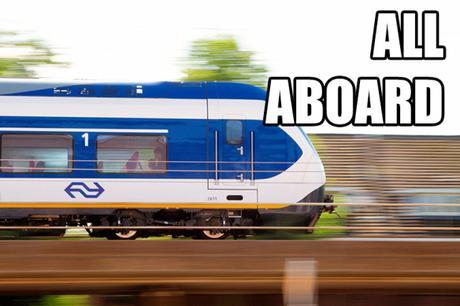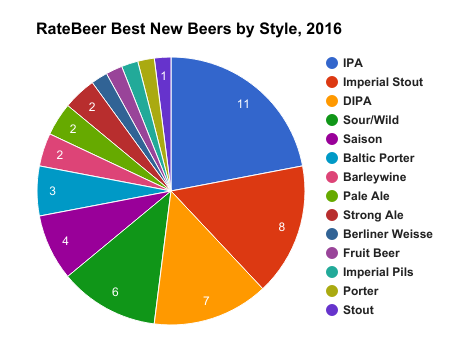 More: Read my first post on RateBeer's best in 2016
More: Read my first post on RateBeer's best in 2016 There are a lot of layers when it comes to "best beer" lists. Subjective opinion, especially on experiential goods, is perfect for controversy. A limited list is going to leave something out of consideration, then it's left to others and an almost innate need to fill in the gaps.
This is one of the reasons I love curating my annual "best beer" list, because as much as it can, it makes the process more objective by consulting numerous people and viewpoints. It may not be perfect, but it's an excellent way to get a feel for the trends and topics that drive a year in beer.
An initial analysis of RateBeer's top 100 beers from 2016 has seemingly added context to a growing body of evidence documented on this blog concerning the connection between beer styles, rarity and perception of quality. This is not meant to be seen as a "good or bad" thing, although you're free to assume how you wish. But rather, as we're able to compile data to support our experiences, it simply becomes "a thing" that we need to address.
For a thorough breakdown of data from the top 100 beers of 2016, as determined by RateBeer users, see this post. There are many points of information to consider from that collection, most notably around the idea of rarity and quality.
But there's plenty leftover, too.
For example, of 59 beers that were included in 2016's "best of" list by RateBeer that weren't on the 2015 list, just over 64% of the new brands are classified by style as imperial stout, DIPA or IPA. As suggested in my previous post, even though other styles are present on the list, it's starting to feel as if anything that doesn't fall into one of those three categories is something of an afterthought to rating site users. (This isn't to say that there aren't highly-rated beers from other styles, but just not many that appear on these lists)
For as much as the overall top 100 offers us, it's also worth considering the "best new beers " determined by RateBeer, an annual collection of 50 brands newly released each year. In this context, imperial stout, DIPA and IPA/NE IPA are 56% of the beers:

But what likely matters most, in terms of our discussion, is a peek at rarity. Of the 50, beers had descriptive notes that included:
- "350 bottles. Produced with self-picked schaarbeekse cherries" (15 ratings)
- "Rarest barrel-aged beer we have ever made" (11 ratings)
- "First available at Copenhagen Beer Celebration 2016" (74 ratings)
Seventeen of the 50 beers were barrel-aged, signaling to the effort, rarity and even authenticity that drinkers may We've also got eight NE IPAs out of 17 hoppy beers, so take that for what you will, knowing how they're associate with quality. Taking this a step further, I count two of the 50 as beers a normal human would be able to get by walking into a bottle shop, with the caveat that 23 of the 50 are made outside of the U.S., a point worth considering as some of the densest user bases for RateBeer can now be found in non-American countries, emphasized by the produced and sold. top users on the site.
One thing that most interests me comes from comparing 2015's best new beer vs. 2016. First, there's a clear difference between the averaged weighted rating between the 50 best *new* beers and the 100 best overall:
Note the rather significant jump in weighted ratings from beer newly released. Part of this is just plain, common sense. Beers like Dark Lord, Hunahpu, Westy 12 and the like are all considered world-class beers. Because we're lumping them in with the overall top 100, of course the averaged rating for that set of beers would be higher.
However, focusing on the top 100, I wonder if there's the potential for a trend at play. From the last two years of RateBeer's top 100, here are the averaged weighted ratings for beers that were kicked off the list, the beers that returned from one year to the next and the new beers added to the overall 100:
Again, the returning beers include sought after brands from Hill Farmstead, Firestone Walker, Cantillon and more. That number is going to be higher. But it got me thinking:
- If the new release beer list has a significantly lower average rating;
- And the new beers added to the top 100 do, too;
- What's the reason for this?
My brain keeps coming back to this: rarity and hype. Could it be that the discrepancy between these scores highlights the chain of word of mouth? All these beers are likely to be considered out-of-this-world good, but the new beers - whether listed on the actual RateBeer Best New Releases list or those added to the overall top 100 - still need to" ramp up speed," in a sense, to get everyone to buy in with their best of the best quality. These beers may not yet have the message boards fired up or beer geeks talking in hushed tones about their quality.
Essentially, what's the psychological timeline it takes for a beer to go from good to great? Because it seems the newness (both in terms of release and familiarity) may have something to do with it.
Something to consider next time you sit down with your limited batch imperial stout you'll only ever drink once.
Bryan Roth
"Don't drink to get drunk. Drink to enjoy life." - Jack Kerouac

